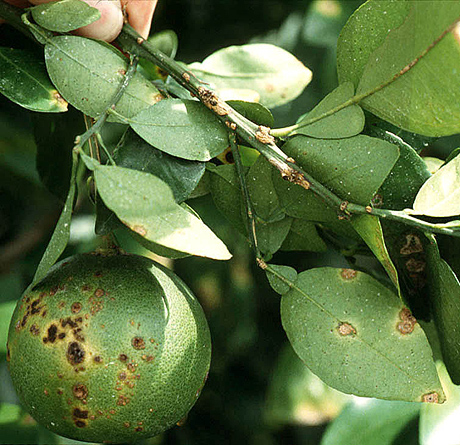The disease of citrus canker is spread by a particular bacteria and wherever this disease attacked in the world, this disease rapidly engulfed the gardens and in many countries of the world, thousands of acres of orchards had to be destroyed due to citrus canker disease. Lemon, grapefruit and sweeteners are highly attacked in citrus fruits, but in other countries, mixed varieties of oranges and some citrus fruits are also reported to be affected by it. In Punjab Province. The area under cultivation of citrus fruits is about 450,000 acres and out of the total orchards, there are only well gardens on 335,000 acres. Kannu, which is exported to other countries, it is very important to protect the fruit of the well from the disease of Coasters Canker, so gardeners should follow the instructions of the Agricultural Scientists of the Citrus Research Institute on an emergency basis to prevent the disease of Citrus Canker so that gardeners at home and abroad can get the right price for their fruit. Citrus canker disease is caused by bacteria, which affects leaves, branches, fruits and other parts of the plant. In the event of a severe attack of the disease, the health and productivity of the plant is affected. Which drastically reduces the delivery and price of the affected fruit. The disease was reported in the subcontinent in 1942 and is now found in all the fruit-producing countries of the world. Citrus Canker’s disease is of economic importance. This disease of orchards is increasing day by day in the world. Symptoms of citrus canker disease include small circle-shaped brown spots on leaves, leaves, branches, twigs, thorns, fruit stalks and fruit skin. The severe attack of the disease occurs on new leaf branches and fruit. On the leaves, this disease appears in the form of small bulges. These bulges are first dark green in color, which later turn dark brown and hard, and their hardness is clearly felt by touching them.
These marks start from the point of a needle and grow up to 10 mm and the role of the host plant, favorable weather conditions and the age of the plant is important in the growth of these marks. Many of the markings together form a large field that, first white or gray, and eventually cracks from the middle after being rough and hard, and millions of spores emerge from it and spread. Due to the attack of disease on the leaves of the flowers and the middle branch of the leaf, the worm and leaves of immature fruit fall, which makes the plant look ugly. The plant dies due to the increase of disease on the shoots and branches. The signs of disease on large branches are irregular, rough and very clear. The inner pulp of the fruit is safe. Affected fruits have no value in the market In case of a severe attack of the disease, the fruit worm can be And in addition to reducing the productivity of the plant, the plant can dry up and die. Germs live in winter in infected plants, leaves and shoots, disease germs are found in infected leaves for one year. In branches and skin, these bacteria are able to cause disease for 3 to 6 years. This bacterium can live for 52 days in disease-free soil and 7 to 9 days in diseased soil. Disease spreads through natural leaf pores or wounds. For the disease to spread, the temperature is 20 to 35 degrees Celsius, while the abundance of rain and the presence of moisture on the outer surface of the host plant for about 20 minutes is necessary. The germ first affects the outer surface of the plant. These microbes are unicellular and rod-shaped and can also live in the roots of some grasses. Strong winds, insects and humans play an important role in spreading the disease.
If the wind speed is 18 kilometers per hour, then the germs of this disease can quickly engulf the gardens for miles. In addition, citrus leaf miner, especially the deep vines that attack the new sprout, forms deep heads on the leaves, in which the bacteria of citrus canker accumulate and it spreads a lot as soon as the horizon conditions are found, later the disease spreads by falling on the diseased water leaves, branches and fruit. From one place to another, the disease spreads through infected plants, infected patchy branches, nursery stock, nursery workers, tools and equipment used in gardens. In addition, dumping infected waste from citrus factories near gardens also increases the chances of spreading the disease. When the leaves, stems and fruits mature, they have strong resistance to the disease. Disease attack occurs within seven days of a new outbreaking the first three months of flowering, the fruit is more affected by the disease. Infections after three months cause small and incomplete signs of disease. In different varieties of orchards, leprosy of citrus fruits is more severely attacked on grab fruit and paper lime. However, his attack on the new gardens of Kanoo has also come under attack. Younger plants are more susceptible to the disease than older plants. Cultivate resistant varieties to prevent citrus canker. Cut off and burn disease-affected parts of disease-infected plants. Collect the leaves of the disease-affected plant and burn it. Plant new plants again after at least two years in a place from where the disease-infected plants have been removed. All other host plants in the nursery should be destroyed. Nursery and garden-related tools should be washed with a disease-free solution. When plants are wet or moist, farming should be avoided in them. Treat leaf miner with a spray. Safety measures should be strictly followed at the time of leaf and branching of the disease-affected plant. In the gardens, first eliminate the leaves, branches and fruit affected by citrus canker, and if the severity of the disease is seen in any place, then prune the plants and burn the branches while going towards the attack of low-intensity disease. Do not use scissors or saws used during branching of disease-infected plants for any healthy plant. Proper farming issues and spray help in the prevention of disease. Branching of parts of disease-infected plants weakens the effect of germs. Be sure to consult the local staff of the Agriculture Department before using any kind of poison.
Citrus canker (leprosy) disease and prevention in citrus fruits
62
previous post

